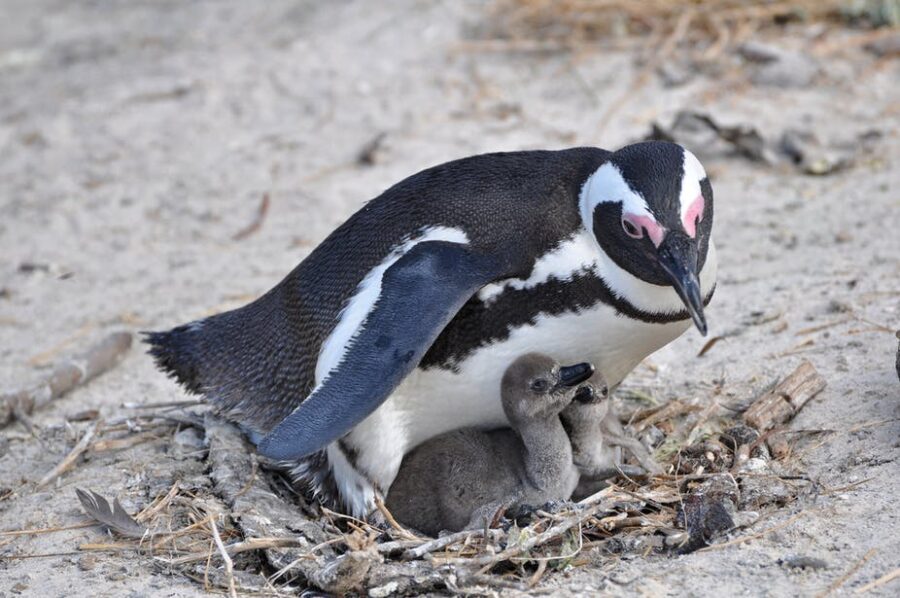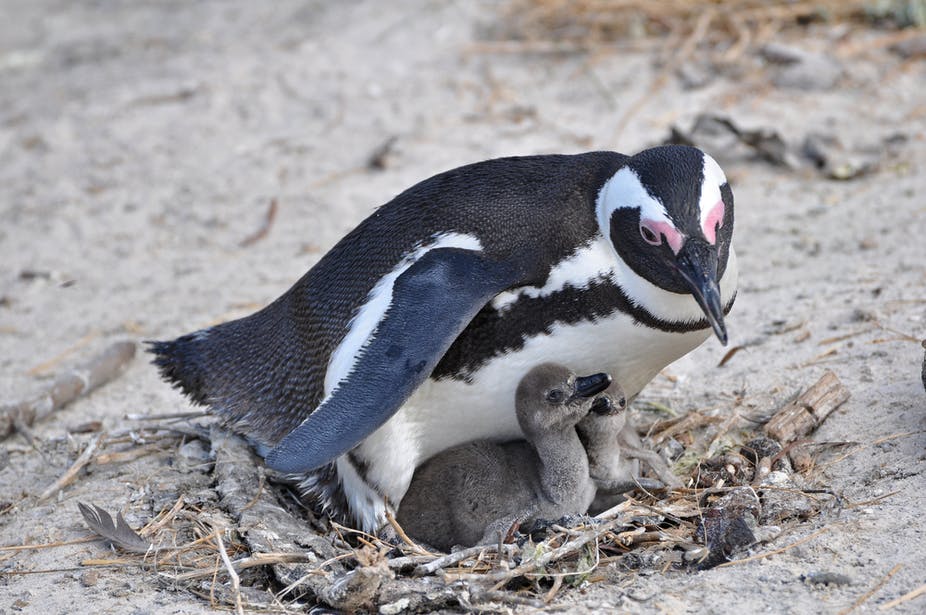
Artificial Nests Can Help African Penguins Breed – But Parasites Like Them Too
The African penguin (Spheniscus demersus) population has declined by over 95% since the 1900s and by nearly 65% over the past 30 years. In the early 1900s, there were an estimated 1.5 million to 3 million African penguins inhabiting islands off the coast of southern Africa. By last year, this had fallen to about 17,900 […]

The African penguin (Spheniscus demersus) population has declined by over 95% since the 1900s and by nearly 65% over the past 30 years.
In the early 1900s, there were an estimated 1.5 million to 3 million African penguins inhabiting islands off the coast of southern Africa. By last year, this had fallen to about 17,900 breeding pairs or 35,800 breeding individuals.
One of the reasons behind this dramatic decline is habitat destruction. Guano, which African penguins use to build burrows, lay eggs and raise their chicks, was harvested at an industrial scale to be used as fertiliser. Consequently, penguins were forced to build open surface nests, which are more exposed to the weather and to predators such as kelp gulls.
Penguins are also sensitive to ecosystem changes such as reduction of available prey, pollution and climate change.
A decline in the African penguin population has major knock-on effects for ecosystems. Penguins feed primarily on pelagic fish and carry their nutrients to their breeding sites on land. This influences ecosystems at the colony and at sea.
Penguins, their eggs and chicks are also food sources for other animals such as gulls and seals. Their presence and abundance is a sign of a healthy and balanced ecosystem.
Artificial nests for African Penguins
One way of protecting penguins has been to put artificial nests in colonies. These nests are closed and provide protection from predators and extreme weather. They’ve also been shown to increase breeding success.
The South African government, as part of the African penguin Biodiversity Management Plan, has highlighted the need to investigate the most suitable nest designs as well as the improvement of breeding habitat through provision of vegetation.
Researchers have assessed artificial nests in various shapes and construction materials at colonies in South Africa and Namibia. It’s essential that their microclimates mimic the natural burrows as closely as possible. They also have to avoid problems such as promoting parasite build-up.
Some materials, particularly fibreglass, create dry and excessively warm environments within the nest. These conditions are known to suit nest-dwelling ectoparasites such as soft ticks and fleas.
Nest characteristics, such as type (natural or artificial), reuse, position in the colony, orientation and entrance opening, can also influence parasite infestations.
In recent years, the conservation authority (CapeNature) has raised concern about ectoparasites on penguins and their nests, and the health of chicks at some colonies. Ectoparasites can be bad for the birds’ condition and transmit disease.
It was therefore important to find out which nest types and characteristics had the most ectoparasites.
The research on African Penguins
Our study took place in 2016 and 2017 at the Stony Point penguin colony, one of the largest in South Africa. We selected penguins (adults and their chicks) in different nest types. These were: natural open nests (exposed on the ground); natural nests covered with vegetation; and artificial cement or fibreglass nests. We collected soft ticks and fleas from the penguins and their nests, blood samples from adult penguins and their chicks, and other health status indicators such as weight and body condition.

In the nests, we recorded the soil temperature and moisture levels. We also recorded the nest type, how long the nest had been present in the colony, distance from the coast, orientation towards or away from the wind, and entrance opening size.
One of the main findings was that artificial nests harboured higher ectoparasite loads than natural nests. We think this might be related to the warm and dry conditions that we found in artificial nests.
Nest-dwelling ectoparasites thrive in high temperatures and dry nest conditions. Fibreglass and cement-fibre nests create these conditions by keeping out rain and retaining heat.
Current artificial nest designs may also be a factor. Their narrow entrances limit ventilation and increase nest temperatures. Nest location also influenced ectoparasite loads. Nests closer to the coastline on rocky or bare soil had higher ectoparasite loads and were drier than nests surrounded by vegetation further inland.
We found an association between lower penguin health and warmer and drier nest conditions. But penguins in natural open nests had a lower average body weight. This could be related to higher exposure to weather and predators.
These results show a close relationship between artificial nests made from fibreglass or cement-fibre and ectoparasite populations.
This information can help colony managers decide what to do about using artificial nests. They can also select more suitable nest sites, for example in colder shady areas.
African Penguin Nest Management
Artificial nests can increase the breeding success of African penguins but this must be weighed against their disadvantages, namely their role in promoting ectoparasite population growth.
In light of our findings, all colonies should be monitored to assess the relationship between nests (natural and artificial), parasites and breeding success of the penguins in those nests.
In addition, choosing different building materials and designs that allow for better ventilation of the nests, may assist in preventing further increases in nest ectoparasite populations and thereby help conservation efforts of this endangered species.![]()
Marcela Espinaze, Postdoctoral research fellow in the Department of Mathematical Sciences, Faculty of Science, Stellenbosch University
This article is republished from The Conversation under a Creative Commons license. Read the original article.
